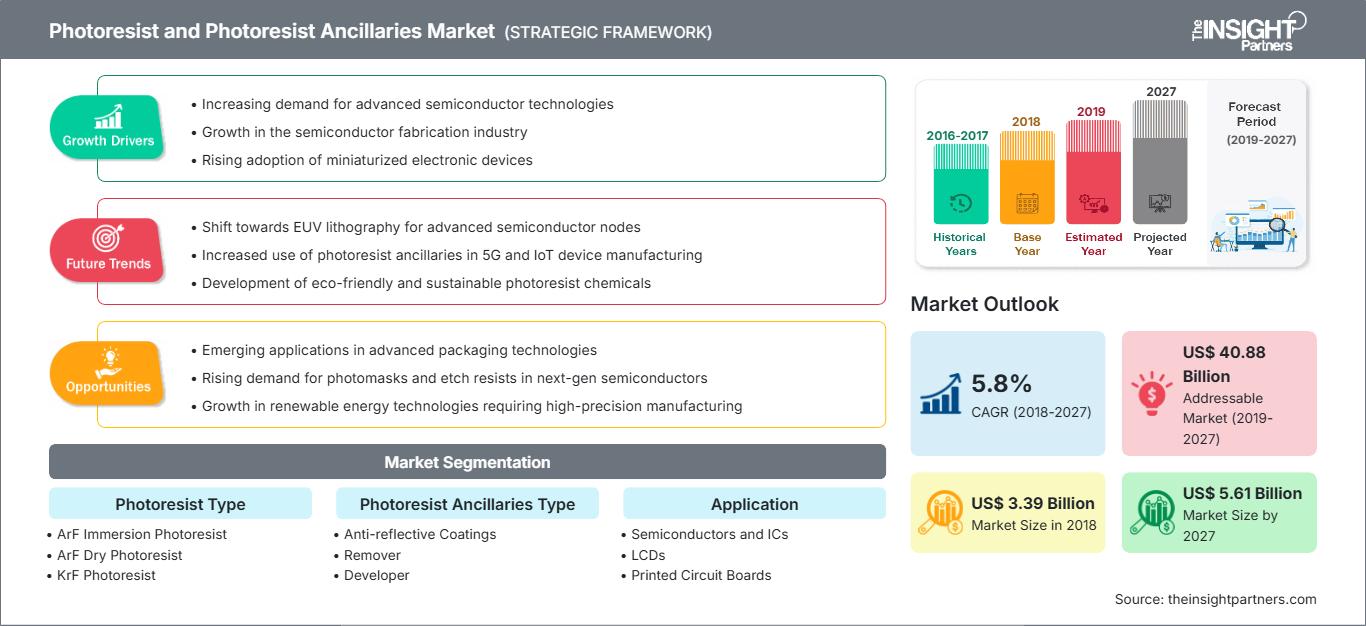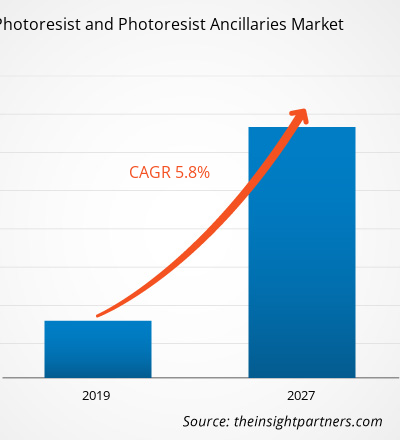Der Markt für Fotolacke und Fotolackzubehör wurde 2018 auf 3.392,97 Millionen US-Dollar geschätzt und soll bis 2027 voraussichtlich 5.614,37 Millionen US-Dollar erreichen; von 2019 bis 2027 wird ein durchschnittliches jährliches Wachstum von 5,8 % erwartet.
Fotolacke sind lichtempfindliche Polymerharze, die hauptsächlich bei der Herstellung von Leiterplatten, Druckplatten, Flüssigkristall-Flachbildschirmen, Magnetschreibköpfen und mikroelektromechanischen Systemen (MEMS) verwendet werden. Diese Komponenten dienen als Maskierungsmaterial für die Übertragung von Bildern auf ein darunterliegendes Substrat durch Ätzprozesse. Fotolackzubehör sind Materialien wie Fotolack-Stripper, Antireflexbeschichtungen, Entwickler und Randperlenentferner, die zusammen mit Fotolack verwendet werden. Die Fotolacke und Fotolackhilfsmittel werden bei der Verdrahtung von mehrschichtigen Halbleitern zur Herstellung von Computern, Laptops, Musikplayern, Telefonen, Servern und Haushaltsgeräten verwendet. Die Elektronikindustrie erlebt in den Industrie- und Entwicklungsländern ein stetiges Wachstum. Die in diesem Bereich tätigen Unternehmen verwenden Fotolacke und Fotolackhilfsmittel zur Herstellung von Produkten wie modernen Telefonen, Computersystemen, Fernsehgeräten und Unterhaltungselektronik sowie elektronischen Steuerungs- und Überwachungsgeräten, die in vielen industriellen und wissenschaftlichen Anwendungen eingesetzt werden.
Nordamerika wird im Prognosezeitraum voraussichtlich mit 6,0 % die höchste durchschnittliche jährliche Wachstumsrate (CAGR) erreichen. Mehrere in- und ausländische Unternehmen haben sich in Nordamerika stark etabliert. Die Unternehmen verbessern kontinuierlich ihre gesamten Geschäftsprozesse, um die Kundennachfrage bestmöglich zu erfüllen. Mehrere in- und ausländische Unternehmen haben sich in Nordamerika stark etabliert. In der Region Nordamerika sind die USA ein wichtiger Markt für Fotolacke und Fotolackzubehör, gefolgt von Kanada und Mexiko.
Der Ausbruch von COVID-19 begann im Dezember 2019 in Wuhan (China) und hat sich seitdem rasant über den Globus verbreitet. China, Italien, Iran, Spanien, die Republik Korea, Frankreich, Deutschland und die USA gehörten im Hinblick auf die Zahl der positiv Getesteten und der gemeldeten Todesfälle im März 2020 zu den am schlimmsten betroffenen Ländern. Den neuesten Zahlen der WHO zufolge gibt es weltweit etwa 332.930 bestätigte Fälle und insgesamt 14.510 Todesfälle. Der Ausbruch von COVID-19 hat aufgrund von Ausgangssperren, Reiseverboten und Geschäftsschließungen die Volkswirtschaften und Industrien in zahlreichen Ländern beeinträchtigt. Die globale Chemie- und Werkstoffindustrie ist einer der wichtigsten Wirtschaftszweige, die infolge dieses Ausbruchs unter schweren Störungen wie Unterbrechungen der Lieferkette, Absagen von Technologieveranstaltungen und Büroschließungen zu leiden hat. China beispielsweise ist das globale Zentrum der Fertigung und der größte Rohstofflieferant für zahlreiche Branchen. Der allgemeine Markteinbruch aufgrund von COVID-19 beeinträchtigt aufgrund von Fabrikschließungen, Hindernissen in der Lieferkette und einem Abschwung der Weltwirtschaft auch das Wachstum des Marktes für Fotolacke und Fotolackzubehör.
Passen Sie diesen Bericht Ihren Anforderungen an
Sie erhalten kostenlos Anpassungen an jedem Bericht, einschließlich Teilen dieses Berichts oder einer Analyse auf Länderebene, eines Excel-Datenpakets sowie tolle Angebote und Rabatte für Start-ups und Universitäten.
Markt für Fotolacke und Fotolackzubehör: Strategische Einblicke

-
Holen Sie sich die wichtigsten Markttrends aus diesem Bericht.Dieses KOSTENLOSE Beispiel umfasst Datenanalysen, die von Markttrends bis hin zu Schätzungen und Prognosen reichen.
Markteinblicke: Die steigende Nachfrage aus verschiedenen Anwendungen hat den Markt für Fotolacke und Fotolackzubehör weltweit begünstigt.
Die steigende Nachfrage aus verschiedenen Anwendungen wie Halbleitern und ICs, LCDs und Leiterplatten treibt den Markt für Fotolacke und Fotolackzubehör weltweit an. Einer der wichtigsten Wachstumsfaktoren für den Markt für Fotolacke und Fotolackzubehör ist deren Verwendung in Flachbildschirmen. Da diese Displays dünner, leichter und energieeffizienter sind, werden sie anderen Displays vorgezogen und stimulieren so das Marktwachstum in Industrie- und Entwicklungsländern wie den USA, Großbritannien, Italien, China, Indien, Russland, Japan, Mexiko und Kanada. Darüber hinaus werden Fotolacke auch in der Verdrahtungskonfiguration bei der Herstellung mehrschichtiger Halbleiter verwendet, die einen wichtigen Bestandteil von Laptops, Computern, Musikplayern, Telefonen, Servern und Haushaltsgeräten bilden. Fotolacke sind lichtempfindliche Polymerharze, die hauptsächlich bei der Herstellung von Leiterplatten, Druckplatten, Flüssigkristall-Flachbildschirmen, magnetischen Aufzeichnungsköpfen und mikroelektromechanischen Systemen (MEMS) verwendet werden. Diese Komponenten dienen als Maskierungsmaterial für die Übertragung von Bildern auf ein darunterliegendes Substrat mittels Ätzprozessen. Fotolack-Hilfsmittel sind Materialien wie Fotolack-Stripper, Antireflexbeschichtungen, Entwickler und Randperlenentferner, die zusammen mit Fotolack verwendet werden.
Anwendungseinblicke
Basierend auf der Anwendung ist der Markt für Fotolacke und Fotolack-Hilfsmittel in ArF-Immersionsfotolack, ArF-Trockenfotolack, KrF-Fotolack sowie G-Linien- und I-Linien-Fotolack unterteilt. Im Jahr 2018 hatte das Segment ArF-Immersionsfotolack den größten Anteil am weltweiten Markt für Fotolacke und Fotolack-Hilfsmittel. allerdings wird erwartet, dass das Segment der G-Linien- und I-Linien-Fotolacke im Prognosezeitraum eine höhere durchschnittliche jährliche Wachstumsrate (CAGR) verzeichnet. Sie gelten als hervorragendes Prozessfenster mit Gleichmäßigkeit der kritischen Abmessung (CD), die eine bessere Profilform des Produkts ermöglicht. Diese Produkte decken die Bedürfnisse der wachsenden Zahl von Verbrauchern der städtischen Mittelschicht ab, die bereit sind, einen höheren Preis für Fotolack und Fotolackzubehör zu zahlen.
Einblicke in die Arten von Fotolackzubehör
Basierend auf der Art des Fotolackzubehörs ist der Markt für Fotolack und Fotolackzubehör in Antireflexbeschichtungen, Entferner, Entwickler und Sonstiges unterteilt. Das Segment der Antireflexbeschichtungen machte den größten Anteil des globalen Marktes für Fotolack und Fotolackzubehör aus; das Segment der Entferner dürfte jedoch im Prognosezeitraum die höchste Wachstumsrate verzeichnen. Antireflexbeschichtungen werden der Produktklasse der Fotolackzubehöre zugeordnet, die bei der Kontrolle der Reflexion helfen und das Licht während der Fotolithografie absorbieren. Sie zeichnen sich durch zahlreiche vorteilhafte Eigenschaften aus, wie die Unterdrückung von Mehrfachreflexionen und die Verbesserung des Kontrasts. Diese Beschichtungen tragen direkt zur Senkung der Betriebskosten in der Elektronikindustrie bei. Antireflexbeschichtungen unterstützen sowohl herkömmliche 365-nm-Prozesse (I-Line) als auch modernste 193-nm-Immersionsverfahren. Diese Materialien bieten ein dynamisches Prozessfenster, eine breite Fotolackkompatibilität und die Möglichkeit, das gewünschte Muster zu erzeugen.
Markt für Fotolacke und Fotolackzubehör
Die Analysten von The Insight Partners haben die regionalen Trends und Faktoren, die den Markt für Fotolacke und Fotolackzubehör im Prognosezeitraum beeinflussen, ausführlich erläutert. In diesem Abschnitt werden auch die Marktsegmente und die geografische Lage von Fotolacken und Fotolackzubehör in Nordamerika, Europa, im asiatisch-pazifischen Raum, im Nahen Osten und Afrika sowie in Süd- und Mittelamerika erläutert.Umfang des Marktberichts über Fotolacke und Fotolackzubehör
| Berichtsattribut | Einzelheiten |
|---|---|
| Marktgröße in 2018 | US$ 3.39 Billion |
| Marktgröße nach 2027 | US$ 5.61 Billion |
| Globale CAGR (2018 - 2027) | 5.8% |
| Historische Daten | 2016-2017 |
| Prognosezeitraum | 2019-2027 |
| Abgedeckte Segmente |
By Fotolacktyp
|
| Abgedeckte Regionen und Länder |
Nordamerika
|
| Marktführer und wichtige Unternehmensprofile |
|
Dichte der Marktteilnehmer für Fotolacke und Fotolackzubehör: Verständnis ihrer Auswirkungen auf die Geschäftsdynamik
Der Markt für Fotolacke und Fotolackzubehör wächst rasant. Dies ist auf die steigende Endverbrauchernachfrage zurückzuführen, die auf Faktoren wie veränderte Verbraucherpräferenzen, technologische Fortschritte und ein stärkeres Bewusstsein für die Produktvorteile zurückzuführen ist. Mit der steigenden Nachfrage erweitern Unternehmen ihr Angebot, entwickeln Innovationen, um den Bedürfnissen der Verbraucher gerecht zu werden, und nutzen neue Trends, was das Marktwachstum weiter ankurbelt.
- Holen Sie sich die Markt für Fotolacke und Fotolackzubehör Übersicht der wichtigsten Akteure
- ArF-Immersionsfotolack
- ArF-Trockenfotolack
- KrF-Fotolack
- G-Linien- und I-Linien-Fotolack
Globaler Markt für Fotolacke und Fotolack-Zubehör – Nach Fotolack-Zubehörtyp
- Antireflexbeschichtungen
- Entferner
- Entwickler
- Sonstige
Globaler Markt für Fotolacke und Fotolack-Zubehör – Nach Anwendung
- Halbleiter und ICs
- LCDs
- Leiterplatten
- Sonstige
Firmenprofile
- MERCK KGaA; Unternehmen
- Historische Analyse (2 Jahre), Basisjahr, Prognose (7 Jahre) mit CAGR
- PEST- und SWOT-Analyse
- Marktgröße Wert/Volumen – Global, Regional, Land
- Branchen- und Wettbewerbslandschaft
- Excel-Datensatz
Aktuelle Berichte
Erfahrungsberichte
Grund zum Kauf
- Fundierte Entscheidungsfindung
- Marktdynamik verstehen
- Wettbewerbsanalyse
- Kundeneinblicke
- Marktprognosen
- Risikominimierung
- Strategische Planung
- Investitionsbegründung
- Identifizierung neuer Märkte
- Verbesserung von Marketingstrategien
- Steigerung der Betriebseffizienz
- Anpassung an regulatorische Trends






















 Kostenlose Probe anfordern für - Markt für Fotolacke und Fotolackzubehör
Kostenlose Probe anfordern für - Markt für Fotolacke und Fotolackzubehör